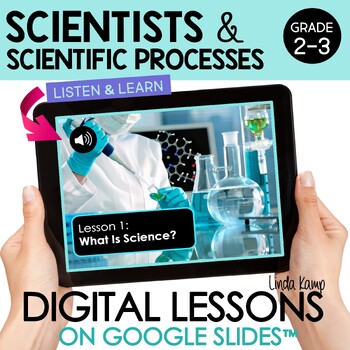Scientists & Scientific Method Digital Science Activities
- PDF
- Google Apps™

What educators are saying
Also included in
- Scientists and the scientific method, science processes-This bundle includes everything you need to teach, practice, experiment, and assess 8-11 days of NGSS aligned lessons, depending on the number of experiments you do. All of the activities are included in both a printable version and in digitalPrice $27.00Original Price $34.00Save $7.00
- This digital science bundle contains six, second grade science units covering properties of matter, habitats & ecosystems, landforms & earth changes, plant and animals needs & life cycles, scientists & the scientific method, and engineering design.The 6 digital second grade science rPrice $57.00Original Price $72.00Save $15.00
- This digital science bundle contains six, third grade science units covering weather and climate, forces, motion and magnets, inherited traits, scientists & the scientific method, environment & survival, fossil evidence, and engineering design.The 6 resources in this bundle are designed as dPrice $64.00Original Price $80.00Save $16.00
Description
This resource is a digital Scientists & Scientific Processes unit for second and third grade with narrated lesson slides, activities, assessments, and interactive games that are easy to use and ideal for whole group lessons or for students to use independently.
Each high-interest lesson slide is narrated so students can click and listen to the slide being read aloud. With the audio feature, the lessons are easily differentiated. Students can listen and learn independently at home or in the classroom. This resource is a digital version of the student activities only from this Scientists & Scientific Processes unit and is intended as an add-on to that unit.
Click here to see the printable unit. Click here for a money-saving bundle of both the print + digital units.
*PLEASE NOTE: This resource is a digital companion to the printable Properties of Matter unit for 2nd grade. It includes Google Slides and Google Forms versions of the student activities and assessments in the main unit. It is not the complete Scientists & Scientific Processes unit and does not include the lesson plans, printable materials, science experiments, labs, teacher binder or any of the printable materials in that unit.
Lesson topics:
- types of scientists & jobs scientists do
- areas of science
- inquiry
- scientific processes
- the scientific method
- science safety
- science tools
All activities in this resource are on Google Slides or Google Forms. The lesson slides have narrated audio files attached so the lessons are read aloud to the student. The slides also have embedded videos to support each lesson. You will need access to YouTube to play the audio files as well as watch the embedded lesson videos.
This download is a clickable PDF with links to the included resources, plus directions for how to use them with students and assign them in Google Classroom. When you click each link, it will prompt you to make a copy for you to save to your Google Drive. This is a digital resource. You will not receive a printable version in this download.
What’s inside:
- 7 Narrated lessons in individual Google Slide presentations
- 7 Digital science journal activities
- Digital quizzes in both multiple choice and fill in the blank format
- Differentiated unit test
- 4 Interactive, literacy-based science games to reinforce reading skills using science content. Students work on: Fact or Opinion, Types of Science, Science Safety Rules, Classifying Science Tools by Use and Purpose
- Teacher directions with pictures, for using and assigning the resources in Google Classroom
- Answer keys for all activities
*Please see the preview for details and pictures of everything included in this unit.
Happy teaching!
Linda Kamp
AroundTheKampfire.com
Additional DIGITAL units with audio lessons:
Scientists & The Scientific Method
Plants & Animals Needs, Life Cycles
Inheritance, Traits & Life Cycles
Click here for all 2nd Grade science units.
Click here for all 3rd Grade science units.
Use science content to build reading skills! Check out these leveled science readers and close reading passages with comprehension questions:
Properties of Matter PRINT & DIGITAL
Landforms & Earth Changes PRINT & DIGITAL
Habitats & Ecosystems PRINT & DIGITAL
Terms of Use
© Linda Kamp. This product may not be posted on a public website, district or school file sharing site, or any shared Drive where others can download it. It may not be used on Outschool or any commercial teaching or tutoring platform. You may not translate or resell this resource.








